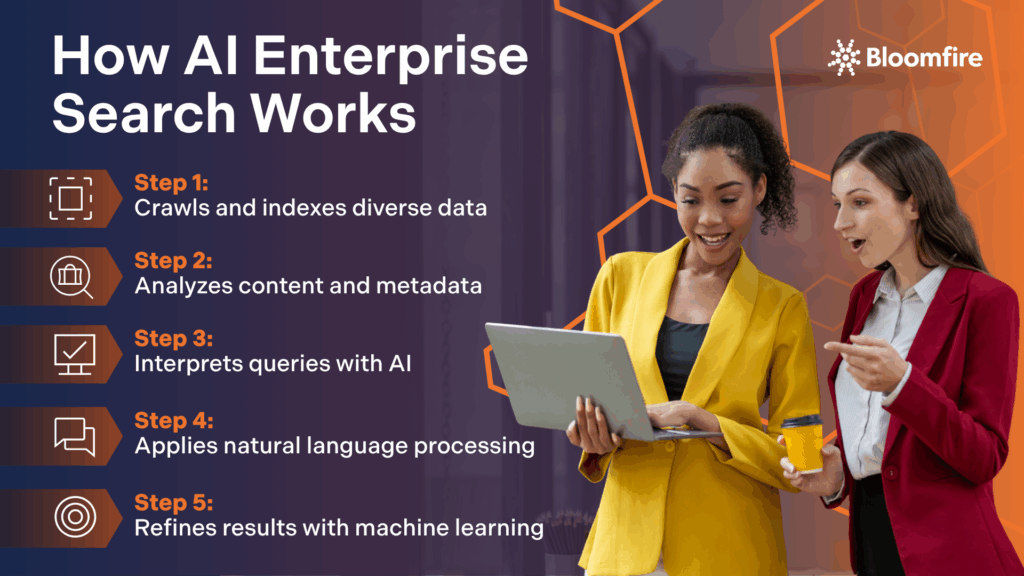How Does AI Enterprise Search Work

In a typical enterprise environment, vast amounts of data are stored across multiple platforms and formats. Navigating this complex digital terrain to find specific information can be a daunting and time-consuming task. It’s a good thing AI enterprise search solutions are designed to seamlessly integrate with these diverse data sources, providing a unified search experience.
Artificial intelligence (AI) enterprise search also incorporates cutting-edge technologies such as machine learning and natural language processing (NLP). These technologies empower the search engine to continuously learn and adapt to user behavior, refining its algorithms over time to deliver increasingly accurate results.
Below, we provide the essential details that answer the new age question: how does AI enterprise search work?
AI Enterprise Search Overview
AI Enterprise Search is a sophisticated technology that leverages artificial intelligence to enhance the search capabilities within an organization. Unlike traditional search engines that rely solely on keyword matching, AI-driven enterprise search solutions utilize advanced algorithms to understand the context and intent behind search queries.
Users can find exactly what they need, even when they don’t know the precise keywords. This enables them to deliver more relevant and personalized results, which can significantly improve efficiency and productivity in the workplace.
How AI Enterprise Search Works
Enterprise AI search transforms how organizations find information. While you can trust the software’s process without getting into the nooks and crannies, you’ll ensure the accuracy and precision of its results if you understand the process. By extension, it will be easier for you to secure leadership buy-in, highlighting the indispensable capacity of an AI-driven enterprise search solution.

Here are the key steps you need to know when diving into how AI enterprise search works:
Step 1: Crawls and indexes diverse data
These systems begin their critical first step by systematically exploring and cataloging information from all your enterprise sources. This includes a vast array of locations such as internal knowledge bases, various cloud storage solutions, content management systems, and even less structured sources like emails and chat logs.
The sheer volume and diversity of data that modern enterprises manage is staggering. As a result, this initial crawling and indexing phase becomes even more essential for any effective search solution.
The global enterprise AI market, valued at approximately $97.2 billion in 2025, is projected to reach $229.3 billion by 2030, exhibiting a compound annual growth rate (CAGR) of 18.9%. This substantial growth is driven, in part, by the increasing demand for efficient data management solutions capable of handling exponentially growing datasets.
Did you know? Organizations will no doubt continue to accumulate more data across disparate systems. The ability of AI enterprise search solutions, like Bloomfire, to thoroughly crawl, index, and make sense of this massive information influx becomes paramount for driving productivity and informed decision-making.
Learn MoreStep 2: Analyzes content and metadata
At this crucial stage, AI-driven enterprise search systems meticulously analyze the content of each document, along with its accompanying metadata. This process involves a thorough examination of the textual information, identifying keywords, phrases, and even the sentiment embedded within the content.
Simultaneously, the systems extract and process metadata, which includes details such as author, creation date, document type, relevant categories, and security permissions. This comprehensive examination is not simply about collecting data; it’s about understanding the relationships between different pieces of information and establishing a rich context for every document.
Step 3: Interprets queries with AI
Advanced AI algorithms then meticulously process your search queries, moving beyond simple keyword matching to grasp your true intent and the inherent context of your words. This deep understanding allows these systems to interpret the nuances of human language, recognizing synonyms, deciphering implied meanings, and even handling complex or ambiguous phrasing.
Rather than just finding documents that contain specific terms, the AI endeavors to understand the question you are truly asking, regardless of how it’s phrased. For instance, if a user searches for “PTO policy,” a traditional system might only return documents explicitly containing “PTO.” However, an AI enterprise search, with its advanced contextual analysis, understands that “PTO” relates to “paid time off,” “leave policy,” or “vacation days.”
The AI-powered workplace search platform will then surface all relevant documents, even if they don’t use the exact abbreviation. This capability significantly reduces the time employees spend sifting through irrelevant results, resulting in a more intuitive and efficient search experience.
Step 4: Applies natural language processing
Natural language processing (NLP) enables systems to truly comprehend user intent, allowing search engines to decipher the complexities of human communication and transform how employees interact with vast internal data repositories.
Instead of requiring users to formulate precise, rigid queries, NLP allows individuals to search using everyday language, making the process far more intuitive and accessible. This capability will enable organizations to deal with a diverse workforce, where not everyone is familiar with specific technical jargon or database structures.
For example, if you ask, “Show me sales figures for Q1 last year from the Western region,” the system doesn’t just look for those exact words; it comprehends that you’re requesting specific data for a particular time frame from a defined geographical area.
Step 5: Refines results with machine learning
Machine learning models are the dynamic force behind continuously improving AI enterprise search. These sophisticated algorithms meticulously observe and learn from user interactions, taking note of which search results receive clicks, the duration users spend on particular pages, and recurring query patterns.
The active analysis embedded in the system helps identify subtle signals indicating what information is most valuable and relevant to individual users and the organization as a whole. It’s an ongoing process where every search refines the system’s understanding, paving the way for more accurate and precisely tailored future results.
Personalization, driven by machine learning, is said to improve clicks to the top search result position by 3.5% and reduce the average error in result ranking by 9.43% over a baseline. The more interactions the machine learning models process, the more adept they become at predicting user intent and delivering exactly what is needed. This level of personalization and precision is a game-changer for enterprise productivity.
Key Features of AI-Powered Workplace Search
AI-powered workplace search solutions offer a range of features designed to enhance the search experience and improve user productivity. Learning these key attributes allows for a seamless selection of a solution that genuinely transforms how your organization accesses and utilizes its vast information repositories. Below are the features you should look for:
- Semantic search: This feature lets you find relevant information even if you use different terminology or phrasing than what’s in the document.
- Personalized search results: AI algorithms analyze individual user behavior and preferences to tailor search results. This ensures you receive the most relevant information based on your role, department, and past interactions with the search engine, cutting down on time wasted sifting through irrelevant data.
- Faceted search and filtering: These tools empower you to refine search results by applying various filters such as date range, file type, author, department, or even custom metadata tags, quickly narrowing down vast amounts of information.
- Content connectors: Robust AI search solutions integrate seamlessly with a wide array of enterprise data sources, including databases, cloud storage platforms, content management systems, etc., ensuring comprehensive coverage.
- Real-time search analytics: Gain valuable insights into search trends, popular queries, and user behavior. Organizations can leverage this data to optimize their information architecture, improve content accessibility, and enhance overall search effectiveness.
- Security and access control: Strict security features ensure that users only see information they are authorized to access, maintaining data confidentiality and compliance.
- Integration with collaboration tools: Often, these solutions can integrate with popular collaboration platforms, allowing users to find and share information without leaving their primary workspace.
Equipping your organization with an AI-powered search solution that contains these critical features means more than just finding documents faster; it empowers employees with immediate access to critical insights. This efficiency translates directly into better decision-making, reduced operational costs, and a more agile, productive workforce that can quickly adapt to changing business needs.
How AI Enterprise Search Uses Enterprise Intelligence
Enterprise Intelligence is the convergence of business intelligence (BI), enterprise search (ES), and knowledge management (KM) into a dynamic ecosystem. This integration ensures that both structured and unstructured data are continuously updated and contextualized. Thus, they easily surface in real-time, empowering employees with insights precisely when and where they need them.
Instead of merely storing knowledge, AI enterprise search actively refines, contextualizes, and delivers information. It bridges the gap between raw data and actionable intelligence. It also identifies gaps, flags redundant or outdated content, and ensures knowledge flows seamlessly across teams, systems, and workflows.
The measurable impact of this shift is significant. Our Value of Enterprise Intelligence Report shows that inefficient knowledge management practices directly affect, on average, 25% of a business’s annual revenue. For a Fortune 500 company generating $9 billion annually, this translates to approximately $2.4 billion in enterprise value at stake each year, impacting revenue, productivity, innovation, and operating costs.
Companies with robust knowledge management programs experience substantial improvements, including a 60.5% faster rate in making critical decisions and a 31% increase in decision-making speed. Furthermore, AI-powered knowledge management systems can save organizations an average of 203 hours per employee annually, showcasing how AI enterprise search directly contributes to a more informed, efficient, and ultimately more profitable operation.
Future Trends in AI Enterprise Search Technology
The future of AI enterprise search promises exciting advancements that will further enhance its capabilities and impact. It is expected that the emphasis will shift towards hyper-personalized knowledge delivery, where AI understands individual roles, projects, and learning styles to provide information tailored to unique requirements. Here are some trends to watch:
- Deeper integration of generative AI: Enterprise search solutions will heavily leverage generative AI to provide synthesized answers, create summaries from multiple sources, and even generate new content based on user queries.
- Voice search integration: As voice-activated devices become increasingly prevalent, integrating voice search capabilities into AI enterprise search will offer more natural and convenient user interactions.
- Augmented reality (AR) and virtual reality (VR): These technologies can provide immersive search experiences, allowing users to visualize and interact with data in new and innovative ways.
- Increased automation: AI-driven enterprise search solutions will incorporate more automation, reducing manual intervention and further streamlining data management and retrieval processes.
- Proactive information delivery and push notifications: Rather than waiting for a user to initiate a search, future systems will proactively deliver relevant information based on an employee’s role, current projects, and evolving needs.
The landscape of enterprise AI is evolving at an unprecedented pace, with new capabilities constantly emerging that reshape how businesses manage and access their internal knowledge. Staying informed about these trends will enable your organization to stay ahead of the curve and leverage the latest advancements in AI enterprise search technology.
Frequently Asked Questions
What is the difference between AI enterprise search and traditional search engines?
AI enterprise search leverages advanced AI technologies, including machine learning and NLP, to deliver more accurate and contextually relevant results. On the other hand, traditional search engines rely on basic keyword matching.
How does AI enterprise search improve productivity in the workplace?
AI enterprise search offers quick and accurate access to information. It reduces the time employees spend searching for data. This allows them to focus on their core tasks and make faster decisions.
Can AI enterprise search integrate with existing systems?
Yes, AI enterprise search solutions are designed to integrate seamlessly with various data sources and systems, providing a unified search experience across the organization. This eliminates information silos and significantly streamlines the process of finding critical data, regardless of its location.
Revolutionize Your Information Access
AI enterprise search is revolutionizing the way organizations access and utilize their data. Understanding how AI enterprise search works allows you to harness its power to enhance efficiency, productivity, and decision-making within your organization. It transforms raw information into actionable insights, enabling every employee to become more effective.
Future-proof your KM program
Explore Bloomfire’s advanced AI enterprise search solution!
See It In Action

Enterprise AI Search: Definition, Benefits, and Evolution

The Benefit of Company-Wide Knowledge Management in 2026

Are You Making These Common Knowledge Sharing Mistakes?

Estimate the Value of Your Knowledge Assets
Use this calculator to see how enterprise intelligence can impact your bottom line. Choose areas of focus, and see tailored calculations that will give you a tangible ROI.

Take a self guided Tour
See Bloomfire in action across several potential configurations. Imagine the potential of your team when they stop searching and start finding critical knowledge.